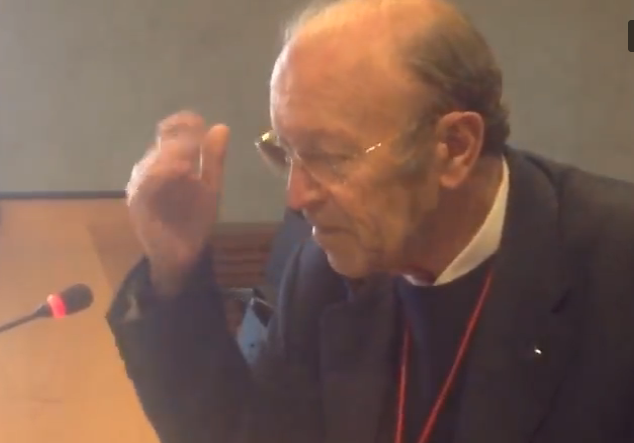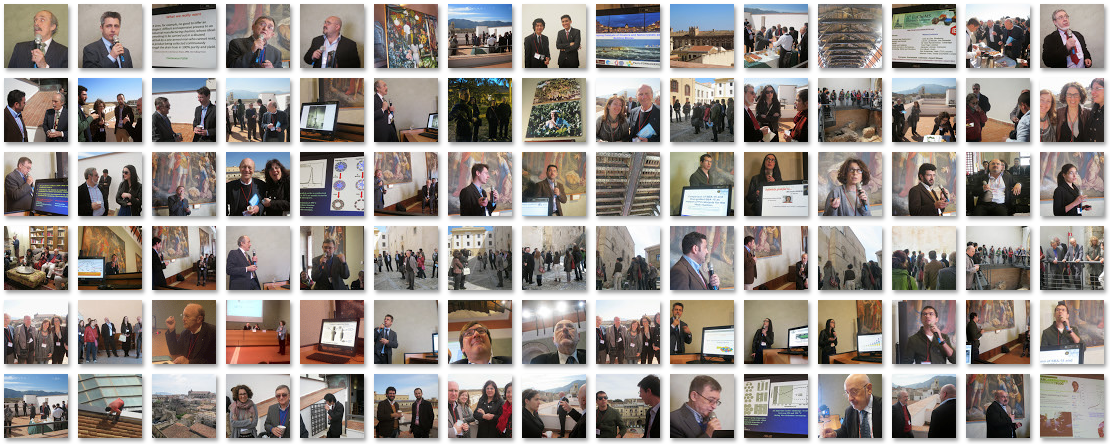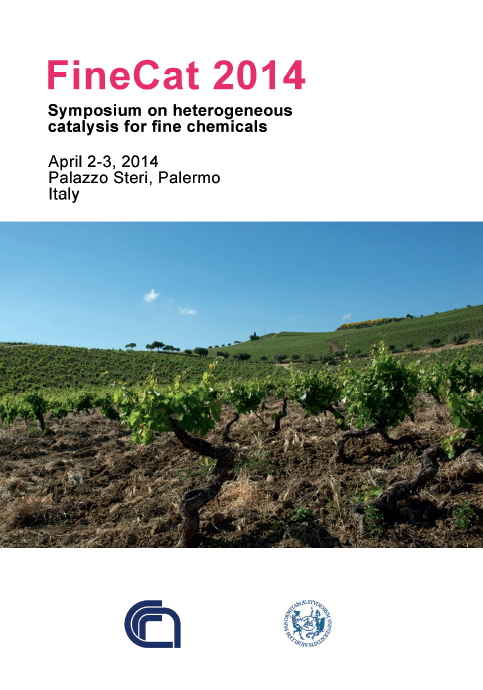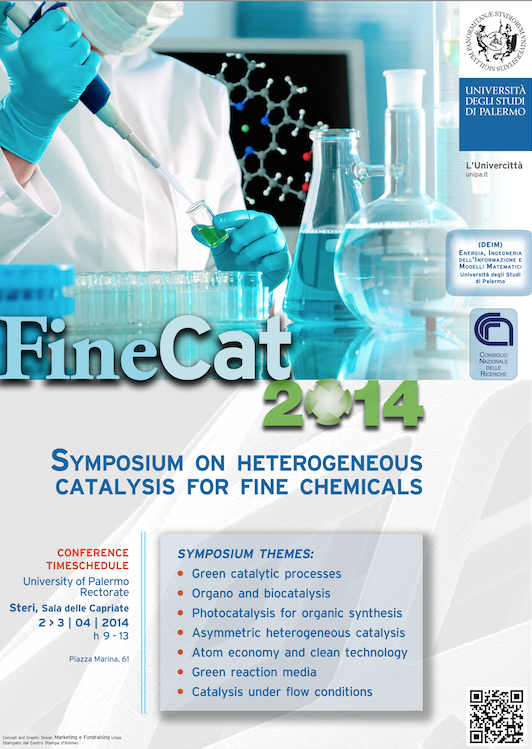| qualitas1998.net
|
FineCat 2014: Great Catalysis Science and Art
Outlook
The scientific program featured 12 symposia and 11 poster presentation that highlighted practically relevant chemical innovation in fields as diverse as flow catalysis, catalysis with metal "Lego" nanoparticles, photocatalysis and biomass catalytic valorization.
Delegates from Slovenia, Thailand, Canada, UK, Italy and Germany showed once again the truly international nature of this Symposium series inaugurated in 2012, that is emerging as a not-to-miss event in the field of heterogeneous molecular and metal catalysis for fine chemicals synthesis. The Book of Abstracts of accepted contributions is now available as eBook on Amazon and all other main digital bookstores online.
Fine chemicals -- polyfunctional molecules with specific properties imparting them high added value -- have traditionally been synthesized via selective homogeneous synthetic methods. All this is now changing as newly developed heterogeneous catalysis emerges as a convenient industrial tool capable to make the fine chemicals industry not only environmentally, but also economically, more sustainable.
Furthermore, biomass feedstock is emerging to replace raw materials of petrochemical origin; thereby closing the materials cycle that makes chemical processes truly sustainable.
Inaugurated by a speech of Palermo's University Pasquale Agozzino dedicated to the memory of the late Professor Vincenzo Romano -- for almost 4 decades eminent professor of analytical chemistry at the same University -- the Symposium saw the invited lectures of the president elect of EuChemS, David Cole-Hamilton as well as of eminent chemists Serge Kaliaguine, Paolo Fornasiero and Jose Antonio Lopez-Sanchez.
"Enzo was a great teacher and a peculiar man with whom to talk about politics, the environment and his love for dogs. I am sure -- concluded his speech Professor Agozzino -- that Enzo today would have preferred to be remembered while playing his piano" (see the video) .

Pictures and video gallery
Invited Lectures and Oral Presentation
On April 2nd, University of St. Andrews and President elect of the European Chemical Society (EuChemS) Professor David Cole-Hamilton opened the meeting with a wonderful lecture on flow catalysis using supported homogeneous catalysts, an hot topic also in industry where a number of pharmaceutical and CMO (contract manufacturing organizations) already make use of manufacturing processes carried out under flow.He described successful flow systems using catalysts supported on solids in ionic liquids or in the reaction product, where the substrate and product flow as liquids or dissolved in supercritical fluids. Reactions covered included the hydroformylation of alkenes to give linear aldehydes, metathesis of methyl oleate, asymmetric hydrogenation to give a product which is a solvent free pure enantiomer and the hydrogenation of amides to amines, a particularly difficult reaction, which is of considerable interest in the pharmaceutical industry.
This topic was addressed also by the oral presentation of Claudio Evangelisti, Istituto di Scienze e Tecnologie Molecolari, CNR, who discussed the use of Pd nanoparticles supported on polyvinylpyridine in C-C coupling reaction under flow.
UniversitÚ Laval's Professor Serge Kaliaguine described the chemical behaviour of newly prepared Ti-SBA-15 silicas in epoxidation catalysis. In an admirable structure-activity relationship crescendo, he showed his team's new approach to post-synthesis low coordination grafting of titanium in mesostructured silica, making use of a chelate titanium precursor generated in situ by action of acetyl acetonate on tetraethyl ortho titanate. Compared with those produced by the more usual one-pot synthesis in cyclohexene epoxidation by tert-butyl hydro peroxide, the new solids thereby obtained were not only more active but also more stable, the optimized ones being fully reusable.
The use of functionalized mesoporous silicas was also dealt with by Rosaria Ciriminna, Istituto per lo Studio dei Materiali Nanostrutturati, CNR, who described the newly developed catalyst made in co-operation with Gadi Rothenberg's team for the enhanced conversion of furfuryl alcohol and butanol into butyl levulinate. The catalyst is the most active and selective so far available for the synthesis of this valued solvent and flavoring agent.

University of Trieste's and KAUST's Professor Paolo Fornasiero described the nanochemistry approach to designing powerful catalysts by manipulation of clusters and nanocrystals as building blocks. Gone are the days in which chemists functionalized solid materials with metal or molecular catalysts and then studied their behaviour. Great Italy's chemist described core-shell architectures, where the noble metal nanoparticles are incorporated within mesoporous metal oxide shells such as CeO2, TiO2 and ZrO2 in which the interface between the two phases is maximized and there is additional protection of the metal nanoparticles towards aggregation, resulting in considerable improvement of the activity in several catalytic processes.
Today, he continued his lecture, we plan the fabrication of solid catalysts in which the active species is thoroughly caged in robust oxide structures whose shape is designed according to application requirements; and this will have a profound impact also on the synthesis of fine chemicals.
University of Liverpool's Jose Antonio Lopez-Sanchez reviewed the opportunities and the open challenges for catalytically converting biomass into value added chemicals, including of fine and speciality chemicals. His scenario lecture put arguments in a wider socioeconomic framework. He explained why the development of new efficient and economically viable routes to chemicals from lignocellulosic biomass is the most important single challenge that we face in order for to commercialize renewable chemicals in a large scale.
If we witness so little practical innovation despite a huge scientific production, further argumented the head of Liverpool's Microbiorefinery facility, this is due to lack of industrial involvement as well as to a lack of customer-centric view. If we want to succeed in seeing our processes go real, he concluded, we should adopt a functional-oriented view by which, for example, the functional polymers we make from biomass are even more performing than the petrochemical counterparts.
Supports are of course crucially important. Hence, Alexander Malyschew, Sasol Olefins & Surfactants, Germany, gave a useful lecture on the use of ultra high purity alumina as an emerging fine catalyst support. His company indeed today manufactures via an analogous nanochemistry approach 2nd generation alumina and alumina-silica supports whose shape, acidity and textural properties are adapted to the customer applicative requirements.
Professor Benjamin Katryniok, University of Lille 1, UnitÚ de Catalyse et Chimie du Solide, presented the results concerning use of lactic acid as a platform chemical for catalytically making pyruvic and acrylic acid. Two processes have been patented within the context of the recently closed EuroBioRef project. He went on explaining why the route to acryilic acid via pyruvaldheyde direct manufacturing seems most promising.
In the same field, University of Milan’s Cristina Della Pina showed how to dictate selectivity in the catalytic conversion of glycerol to either acetol or piruvaldehyde, by carrying out the reaction in gas phase over gold heterogeneous catalysts. Reaction is best carried out at 300 C using hydrogen or osygen mixed to nitrogen as flow carrier to subtly adjust the selectivity.
Utrecht’s University PhD student Rafael Oliveira addressed the influence of thiol grafted on mesoporous SBA-15 silica used in the Heck Reaction.
Francesco Parrino, a post-doc research fellow at the "Schiavello-Grillone" research Group of the University of Palermo, addressed the topic of visible light photocatalysis as a suitable green synthetic technology, mostly through innovative titania-based catalysts. The topic was addressed also by PhD student Melita Rutar, J. Stefan Institute, Slovenia, presenting the synthesis and the catalytic performance of new one dimensional titania catalytic nanostructures.
Poster Presentation
 A
number of Poster presentation impacting relevant areas of contemporary
research in the field were presented at FineCat 2014.
A
number of Poster presentation impacting relevant areas of contemporary
research in the field were presented at FineCat 2014.Phongphat Prawang, The Petroleum and Petrochemical College, Chulalongkorn University, Thailand, described the catalytic activity of Ni supported over mixed oxide in methane reforming. A similar catalyst was described by Kantapong Mongkolhattee, from the same University, for adiponitrile hydrogenation.
Their colleagues Atsadang Traitangwong and Nut Tangphianphan reported new results on, respectively, the steam reforming of oxygenated hydrocarbon mixtures and toluene alkylation with methanol with modified HZSM-5 zeolite.
Giuseppe Pantaleo and Rosa La Mattina, Istituto per lo Studio dei Materiali Nanostrutturati, CNR, described novel structural aspects of sol-gel microspheres doped with glycerol used as polymer curing agents. Their colleagues Maria Luisa Bondý similarly addressed the use of cationic SLN as drug delivery materials. Two other colleagues, Maria Luisa Testa and Maria Pia Casaletto, respectively discussed the use of acid hybrid silicas in esterification reactions and selected structural aspects of newly developed Au catalysts.
Marianna Bellardita and Gabriele Scandura, Dept. DEIM, University of Palermo, described the synthesis of fluorenones via photocatalytic oxidation of phenanthrene and the autocatalytic photo-oxidation of 2-methoxybenzyl alcohol. Finally, Sedat Yurdakal, Dept. of Chemisty, University of Afyon Kocatepe, presented a poster concerning the synthesis of p-anisaldehyde in water under UV and visibile light irradiation over N-doped titania affording enhanced selectivity.
Poster Awards
Three Poster Prizes were awarded. The first prize, a 1 year’s free personal e-subscription to Dalton Transactions, went to Maria Luisa Testa for her poster concerning he use of acid hybrid silicas in esterification reactions. The Prize was kindly offered by RSC Publishing, partnering with the organizers since the very first FineCat symposium.Offered by World Scientific, the 2nd and 3rd prizes -- a copy of the book Design and Applications of Single-Site Heterogeneous Catalysts by John Meurig Thomas -- went to Chulalongkorn University’s student Nut Tangphianphan for his presentation concerning toluene alkylation with methanol with modified HZSM-5 zeolite; and to Maria Pia Casaletto for her contribution devoted to the structural aspects of newly developed Au catalysts.
Press coverage
- Ricerca, i maggiori chimici del mondo si danno appuntamento a Palermo (2-Apr-2014)
- Ricerca: a Palermo il Simposio internazionale FineCat 2014 (2-Apr-2014)
- Ricerca: a Palermo il Simposio internazionale FineCat 2014 (2-Apr-2014)
Towards FineCat 2015
The 4th edition of FineCat will be held in
Sicily on April 8-9, 2015. Further information
Dr M. Pagliaro (mario.pagliaro@cnr.it) - Prof. L. Palmisano (leonardo.palmisano@unipa.it)Back to the FineCat Symposium Home-Page
